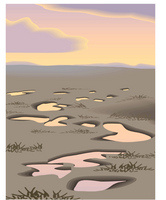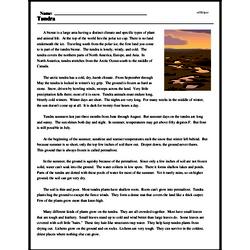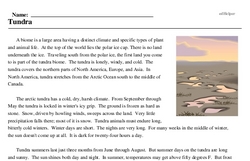Tundra
A biome is a large area having a distinct climate and specific types of plant and animal life. At the top of the world lies the polar ice cap. There is no land underneath the ice. Traveling south from the polar ice, the first land you come to is part of the tundra biome. The tundra is lonely, windy, and cold. The tundra covers the northern parts of North America, Europe, and Asia. In North America, tundra stretches from the Arctic Ocean south to the middle of Canada.
The arctic tundra has a cold, dry, harsh climate. From September through May the tundra is locked in winter's icy grip. The ground is frozen as hard as stone. Snow, driven by howling winds, sweeps across the land. Very little precipitation falls there; most of it is snow. Tundra animals must endure long, bitterly cold winters. Winter days are short. The nights are very long. For many weeks in the middle of winter, the sun doesn't come up at all. It is dark for twenty-four hours a day.
Tundra summers last just three months from June through August. But summer days on the tundra are long and sunny. The sun shines both day and night. In summer, temperatures may get above fifty degrees F. But frost is still possible in July.
At the beginning of the summer, sunshine and warmer temperatures melt the snow that winter left behind. But because summer is so short, only the top few inches of soil thaw out. Deeper down, the ground never thaws. This ground that is always frozen is called permafrost.




